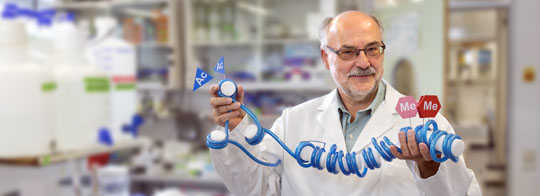Epigenetics key in fighting prostate cancer
Freiburg, Sep 25, 2017
During the past 12 years, Prof. Dr. Roland Schüle, the scientific director of the Department of Urology at the University Medical Center of the University of Freiburg, has rapidly advanced epigenetic research and achieved significant gains in knowledge. His work is focused on the epigenetic enzyme lysine-specific demethylase, or LSD1 for short, which can alter chromatin, the packaging of DNA. Changes in chromatin lead to growth in tumor cells. Blocking the enzyme's function is today being considered as a possible key to treating tumors such as, for example, those associated with prostate cancer. In order to gain further knowledge of the biological functions of LSD1, Schüle received an Advanced Grant from the European Research Council (ERC) in 2014. The sum approved – 2.5 million euros – was the largest grant possible. The financing supplemented the collaborative research center "Medical Epigenetics," which was established in 2012. Roland Schüle is the center's spokesman. ERC grants such as these have been awarded to fifty researchers over the past decade. To mark the anniversary, the University of Freiburg is publishing portraits of ten recipients that offer insight into the projects selected.
 Roland Schüle with a model of chromatin. The researcher is investigating how the enzyme known as LSD1 can alter the packaging of DNA.
Roland Schüle with a model of chromatin. The researcher is investigating how the enzyme known as LSD1 can alter the packaging of DNA.
Photo: Jürgen Gocke
It all began in 2005, when Schüle published an article in the specialist journal "Nature." In it, Schüle described the enzyme LSD1 for the first time and postulated that blocking it could impede the growth of tumor cells. "Back then, there wasn't much more known about LSD1. It was a complete black box," says Schüle. He continued his research and as early as 2008, showed that his hypothesis was correct. An inhibitor was successfully used to block the enzyme in tumor cell cultures to stop the growth of tumor cells. "At this time several biotechnology companies became aware of us, because our findings led to the conclusion that epigenetic therapy could be possible for cancer patients," explains Schüle. In order to reach this goal, he continues, far more knowledge about LSD1 had to be gained. In their research, Schüle and his team concentrated on two areas. The first was the search for the ideal inhibitor. The researchers created a three-dimensional crystal structure of the LSD1 enzyme, which shows a channel in the protein. "Blocking the enzyme works according to a key and lock principle," Schüle elaborates. Using a computer, a synthetic molecule was built that fit in the channel precisely and sealed it. Experiments were carried out in the lab to see if the molecule that had been found actually worked.
A multi-tasking enzyme
The second area of research emphasis was finding out more about the functions of LSD1 – present in all cells – within organisms. "If we develop a drug, then it actually has to work and cause no, or manageable, side effects if possible," says Schüle. The first clinical studies showed that blocking the enzyme caused mild anemia. To find out more about LSD1's functions, the researchers used mice as their model. The bred mice in which LSD1's functions were completely inhibited. They then compared them with different types of tissue and different developmental stages in control animals. With the help of the "knock-out" mice, they have since achieved important results. "LSD1 is very important for stem cell development and differentiation. It is also key to the development of fat cells and muscle tissue, where it plays a significant role," Schüle explains. What is more, the enzyme also regulates the number of blood platelets. They additionally discovered that blocking LSD1 can influence embryonal development. If the enzyme was blocked in the embryos of mice, the embryos died after seven or eight days. Schüle did not see these factors as ruling out finding an effective medication. "You need to know the physiological functions in order to improve LSD1 inhibitors specifically." And when it comes to inhibitors, Schüle is also a major step further with regard to side effects. He has found a reversible inhibitor molecule, meaning that the inhibitor can separate itself from the LSD1 molecule. This results in a significant reduction of adverse reactions.
Creative freedom
A drug may still be a long way off, but Schüle has come far in a relatively short time. Eleven clinical studies have already been completed. That's a considerable achievement, considering that Schüle's center specializes in fundamental research. "It was a high-risk project from the start," he says. What he appreciates about the ERC grant is that it promotes exactly these types of research projects. "Genuine innovation doesn't take place without risk," adds Schüle. He says what makes him even more pleased, is that his collaborative research center has come to be perceived around the world as a center for medical epigenetics. He adds that it's also personally important to him to maintain his creative freedom as a researcher. "A researcher cannot permit anyone to prescribe what he should be researching. He has to pursue what he believes to be right." Financing programs like the ERC grant make that possible.
Petra Völzing

